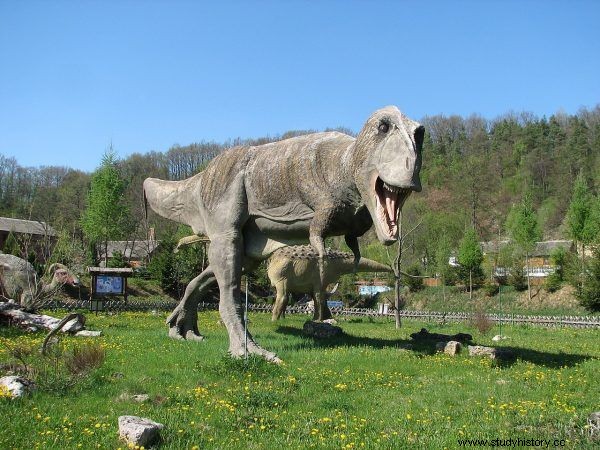There are voices that tyrannosaurs were too stupid and too heavy to hunt. They say they liked rotten meat best. But was it really so? What do we know about the diet of these spine-chilling lizards?
What was the royal feast like? We know that T. rex he was a 100% carnivore. This is one of the simplest conclusions that we can draw about this dinosaur, it does not require resorting to complicated experiments or machines.
Razor sharp teeth
T. rex it had a mouth full of thick, razor-sharp teeth. Its front and rear legs had large, sharp claws. There is only one reason why animals need these kinds of attributes:it is a weapon used to harvest and process meat.
If your teeth look like knives and your fingers have hooks on the ends of your fingers, then you're probably not just eating cabbage. And anyone who has doubts can read a number of other pieces of evidence:bones have been found in the abdomen near the skeletons of tyrannosaurs, as well as in their coprolytes (fossil feces), and western North America is spotted with the skeletons of herbivorous dinosaurs - especially triceratops and edmontosaurs - on with bite marks that perfectly match the size and shape of the teeth T. rexa .

The tyrannosaurus had a jaw full of razor-sharp teeth.
Like many other monarchs, the Rex was a glutton. He devoured meat. Researchers estimated how much food an adult T. rex to survive based on how much modern predators eat, in proportion to size. The results are nauseating. If T. rex had a reptile metabolism, needed about 5.5 kilograms of Triceratops chops per day.
This is very likely to be an underestimated value, as - as we will see later - dinosaurs looked much more like birds than reptiles in behavior and physiology, and were likely (at least mostly) warm-blooded, as are we. If this was the case, the rex had to eat about 111 kilograms of food each day .
That's many tens of thousands of calories, maybe even thousands of thousands - depending on how fat the royal steaks were. About the same amount is eaten by three or four large male lions, which are among the most hungry and energy demanding carnivores of today.

Learn about the extraordinary history of dinosaurs with Steve Brusatte's book "The age of the dinosaurs. From birth to fall ”(Mark Horizon ).
Want a free meal
You may have heard the rumor that T. rex he liked dead and rotten meat that was a scavenger, a 7 ton picker, too slow, too stupid or too big to hunt for fresh food . Similar accusations keep coming back every few years - science journalists love these kinds of stories. Don't believe them.
It makes no sense that an agile and dynamic animal with sharp teeth and a head the size of a small car would not use its body shape to hunt, but only collect leftovers. This theory also contrasts with our understanding of modern carnivores:very few of them are scavengers, and those concerned - vultures, for example - are flying animals that observe large areas from the air and descend to the ground whenever they see (or feel). ) decaying body. On the other hand, most carnivores actively hunt, but also dig up "ready" meat.
Who would eventually refuse a free meal? This applies to lions, cheetahs, wolves and even hyenas, which - contrary to the legend - are not only scavengers, because they kill many of their victims themselves. T. rex like these animals, he was probably both a hunter and a comfortable scavenger.

For the tyrannosaur, carrion was just a convenient, free dinner. Model from JuraPark in Bałtów.
Still in doubt if the rex was hunting its own food? The evidence is also in the fossils. Many of the bones of the Triceratops and Edmontosaurs marked by T. rexa shows signs of healing and healing, which means they must have been attacked and survived .
The most provocative of these specimens is the set of two fused Edmontosaurus tailbones with the T tooth sandwiched between them. rexa surrounded by scarred tissue that bonded them as they healed. The hapless duck-billed dinosaur was attacked by a rabid tyrannosaur and cruelly wounded, but kept the predator's tooth as a trophy.
Source:
The above text originally appeared in the book Steve Brusatte Era of the Dinosaurs. From birth to fall , Which was published by Znak Horyzont.
The title, lead, illustrations with captions, boldface text, explanations in square brackets and subheadings come from the editors. The text has undergone some basic editing to introduce more frequent paragraph breaks.
